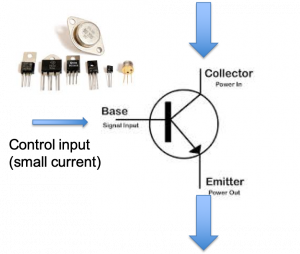Chapter 5. Transistors
This chapter discusses bipolar junction transistors, or BJTs. These are one of two classes of transistors, the other being field effect transistors (FETs) which are not discussed in this text. First we provide a qualitative description of the operation of a BJT and then we provide transistor circuits that function as solid state switches and current amplifiers.
BJT Concept and Application. A bipolar junction transistor is a three-terminal device having terminals referred to as base, collector, and emitter. The device functions analogous to a control valve, wherein a small control signal, namely, a small base current, is used to control a larger current flowing between the collector and the emitter of the transistor as depicted in figure 5.1.

The transistor a solid-state device since it is based on the behavior of semiconductor junctions rather than using moving metal contacts and components as in mechanical on/off switches and flow control valves. A bipolar junction transistor operates in one of three modes:
- cutoff mode, in which the transistor is off and the flow of current from the collector to the emitter is completely blocked, and open circuits exist between all three terminals of the transistor;
- active mode, in which the transistor is partially on (analogous to an LED that is glowing somewhat). In this mode, the amount of current flowing between the collector and emitter, and the voltage drop between the collector and emitter is controlled, or varied, in direct proportion to the base current; and
- saturation mode in which the transistor is fully-on. In this mode, current flows freely between the collector and the emitter, and the voltage drop between the collector and emitter is nearly zero.

